Nocera Inferiore
Nocera Inferiore (Neapolitan: Nucere, IPA: [nuˈ(t)ʃɛːrə], locally [nuˈ(t)ʃæːrə]) is a city and comune in Campania, Italy, in the province of Salerno, at the foot of Monte Albino, 20 kilometres (12 mi) east-southeast of Naples by rail. It has a population of 45,608 inhabitants and a surface of 20.94 square kilometers (8.08 sq mi) thus showing a population density of 2,200 inhabitants per square kilometer. It rises 43 metres above the sea level.
Nocera Inferiore | |
|---|---|
| Comune di Nocera Inferiore | |
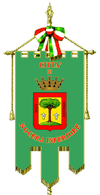 Coat of arms | |
Location of Nocera Inferiore 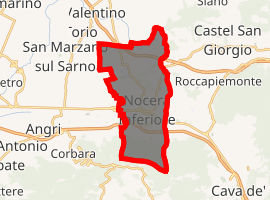
| |
 Nocera Inferiore Location of Nocera Inferiore in Italy  Nocera Inferiore Nocera Inferiore (Campania) | |
| Coordinates: 40°45′N 14°38′E | |
| Country | Italy |
| Region | Campania |
| Province | Salerno (SA) |
| Frazioni | Cicalesi, Merichi, Vescovado, Casolla, San Mauro |
| Government | |
| • Mayor | Manlio Torquato |
| Area | |
| • Total | 20.94 km2 (8.08 sq mi) |
| Elevation | 43 m (141 ft) |
| Population (1 January 2019)[2] | |
| • Total | 45,608 |
| • Density | 2,200/km2 (5,600/sq mi) |
| Demonym(s) | Nocerini |
| Time zone | UTC+1 (CET) |
| • Summer (DST) | UTC+2 (CEST) |
| Postal code | 84014 |
| Dialing code | 081 |
| Patron saint | St. Priscus |
| Saint day | May 9 |
| Website | Official website |
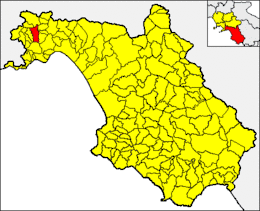
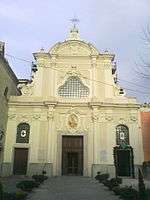


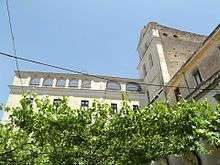

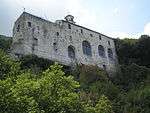
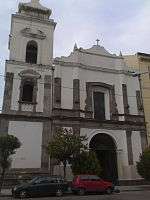
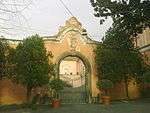
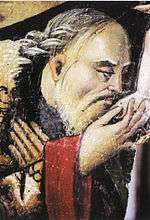
History
In the period before the Roman supremacy in southern Italy, Nuceria Alfaterna, situated between the current Nocera Inferiore and Nocera Superiore, appears to have been the chief town in the valley of the river Sarnus, with Herculaneum, Pompeii, Stabiae and Surrentum all being dependent upon it. Nuceria minted its own money, and developed its own alphabet called nucerino which derived from the Etruscan language. It maintained its allegiance to Rome until 309 BC when it joined the Samnites rebels. In 308 BC, it repulsed a Roman attempt to land at the mouth of the Sarnus, but in 307 BC, it was besieged and surrendered. It obtained favourable terms, and remained faithful to Rome even after Cannae.
Hannibal reduced it in 216 BC to starvation, and destroyed the town. The inhabitants returned when peace was restored. Even during the Social War, Nuceria remained true to Rome, though the dependent towns joined the revolt and there were many riots; after it they were formed into independent communities, and Nuceria received the territory of Stabiae, which had been destroyed by Sulla in 89 BC, as a compensation. In 73 BC it was plundered by Spartacus.
At an early date, the city became an episcopal see, and in the 12th century, it sided with Innocent II against Roger of Sicily, suffering severely for its choice.
In the 13th century, and long after, the town had the name of Nocera de' Pagani (Nocera of the pagans) because a colony of Muslim Saracens was introduced by Frederick II.[3] The town was described as "a genuine Muhammadan town with all its characteristic mosques and minarets."[4] It is said that, through their darker complexion and features, the townsfolk maintain the heritage of these Muslims settlers.[5] Notably, while the town's name was changed from Nocera de' Pagani to Nocera Inferiore, a nearby town, Nuceria Christianorum, was renamed Nocera Superiore.[6]
A small colony of Saracens was actually introduced in the town around the 9th century.
By the end of the 15th century, until 1806 Nuceria had the epithet ("of the pagans", Nuceria Paganorum). Today there is the town of Pagani, which lies about one 1.5 km to the west.
In 1385 Pope Urban VI was besieged in the castle by Charles III of Naples.
The origins of the name
According to a legend, an Etruscan princess escaped from her hometown for love and came to die in these areas. In her memory, her father erected a city, giving it her name, Nuceria. Another legend tells that a great flood swept away an entire wood leaving a single walnut tree (from the Latin nux, nucis - Nuceria). The truth about the origin of the name came from the study of inscriptions on the coins of the city where it can be read Nuvkrinum Alafaternum. Analyzing these two words, the linguists have split the terms in this way:
nuv + krin -um alafartern -um: literally: Nuova (= nuv) Rocca (= krin) of the Alfaterni.
The current name, Nocera Inferiore, derives from the Italianization of the toponym Nuceria and from the geographical position of the city that, in 1806, was born from the division of Nocera dei Pagani, sanctioning the birth of five municipalities, including the two Noceras, differentiated according to their height above sea level.
Main sights
One of the most beautiful places to visit in Nocera Inferiore is the medieval castle. Strategically located on the top of Santa Andrea's hill, this fortified structure was founded in the 9th century. In 1138 it was destroyed by the troops of Ruggero II. Helena, the widow of Manfred of Sicily, was imprisoned in the Castle and died here after the battle of Benevento (1268). Here also Urban VI imprisoned the cardinals who favoured the antipope Clement VII. The castle also had as guests the writers Dante Alighieri and Boccaccio.
About three kilometers to the east, near the village of Nocera Superiore, there is the circular church of Santa Maria Maggiore, dating from the 7[7]th century. Its chief feature is its dome, ceiled with stone internally, but covered externally with a false roof. It is supported by 40 ancient columns, and in its construction resembles Santo Stefano Rotondo in Rome. The walls are covered with frescoes from the 14th century.
Symbols
The city coat of arms shows a walnut tree with golden fruits. On the red frame of the shield is written "Urbs Nuceria" in Roman letters. On the top there is a castellated crown, whereas at the bottom there is a laurel branch with golden berries and an oak branch with golden acorns tied together with the Italian tricolour ribbon. The city coat of arms has been renewed recently by Antonio Pecoraro.
Since 2017 "Verrà dalla memoria" has been the anthemn of Nocera Inferiore. Lyrics were written by Teresa Staiano and music was composed by Father Carmine Ferraioli.
Monuments
Churches
- Cathedral of san Prisco and San Marco (10th century)
- Church of San Matteo (10th century)
- Convent of San Giovanni in Parco (12th century)
- Church of Sant'Angelo in grotta (12th century)
- Monastery of Santa Chiara (13th century)
- Convent of Sant'Antonio (13th century)
- Convent of Sant'Anna (13th century)
- Church of the Corpo di Cristo (16th century)
- Convent of Sant'Andrea (16th century)
- Sanctuary of Santa Maria dei Miracoli (16th century)
- Church of San Bartolomeo (18th century)
- Church of San Giuseppe (20th century)
Castle
- Castello del Parco (10th century)
Buildings
- Torre Guerritore (19th century)
- Palazzo Vescovile (16th century)
- Curia diocesana (18th century)
- Palazzo ducale (16th century)
- Caserma Bruno Tofano (18th century)
- Palazzo Lanzara (17th century)
- Palazzo del Liceo Classico (20th century)
- Villa Piccolomini d'Aragona (20th century)
Museums
- Art gallery of Sant'Antonio convent
- Diocesan Museum San Prisco
- Archaeology museums of Agro nocerino
Notable people
- Publius Sittius
- Publius Vitellius the Elder
- Publius Vitellius the Younger
- Vitellius
- Priscus martyr
- Priscus of Nocera
- Felix and Constantia
- Antipope Laurentius
- Beatrice of Provence
- Helena Angelina Doukaina
- Charles Martel of Anjou
- San Ludovico D'Angiò, canonized on April 7, 1317 by John XXII
- Dietrich of Nieheim
- Pope Urban VI
- Raimondo Del Balzo Orsini
- Jacopo Sannazzaro, famous poet, humanist, and epigrammist
- Nunzio Ferraiuoli, famous painter
- Paolo Giovio
- Bernardino Telesio
- Orazio Solimena, famous painter
- Angelo Solimena, famous painter
- Francesco Solimena, famous painter in the Baroque era
- Carlo Cafiero
- Giuseppe Fanelli
- Warren Cuccurullo
- Domenico Rea
- Mario Cuomo, whose father Andrea came from Nocera Inferiore
- Pat Villani
- Mino Raiola, football agent
- Giammario Piscitella
- Lorenzo Prisco, footballer
- Michele Tarallo
- Simone Barone, World Cup-winning footballer
- Raffaele De Martino, footballer
- Teresa Di Loreto
- Joel Salvi
- Isabella Adinolfi
Transportation
Nocera is connected with Naples, Avellino and Salerno by a branch railway.
Notes and references
- "Superficie di Comuni Province e Regioni italiane al 9 ottobre 2011". Istat. Retrieved 16 March 2019.
- All demographics and other statistics: Italian statistical institute Istat.
- Chisholm, Hugh, ed. (1911). The Encyclopædia britannica: a dictionary of arts, sciences, literature and general information, Volume 19 (11 ed.). The Encyclopædia Britannica Company. p. 730.
- Robert Browning (1984). The Poetical Works of Robert Browning: Volume II. Strafford, Sordello (reprint, annotated ed.). Clarendon Press. p. 300. ISBN 9780198123170.
- Walter Scott (31 Aug 2013). Douglas, David (ed.). The Journal of Sir Walter Scott: Volume 2: From the Original Manuscript at Abbotsford (illustrated ed.). Cambridge University Press. pp. 470–1. ISBN 9781108064309.
In the latter village [Nocera Inferiore] the Saracens obtained a place of refuge, from which it takes the name. It is also said that the circumstance is kept in memory by the complexion and features of this second Nocera, which are peculiarly of the African caste and tincture.
- Walter Scott (31 Aug 2013). Douglas, David (ed.). The Journal of Sir Walter Scott: Volume 2: From the Original Manuscript at Abbotsford (illustrated ed.). Cambridge University Press. p. 470. ISBN 9781108064309.
- Cicer
![]()